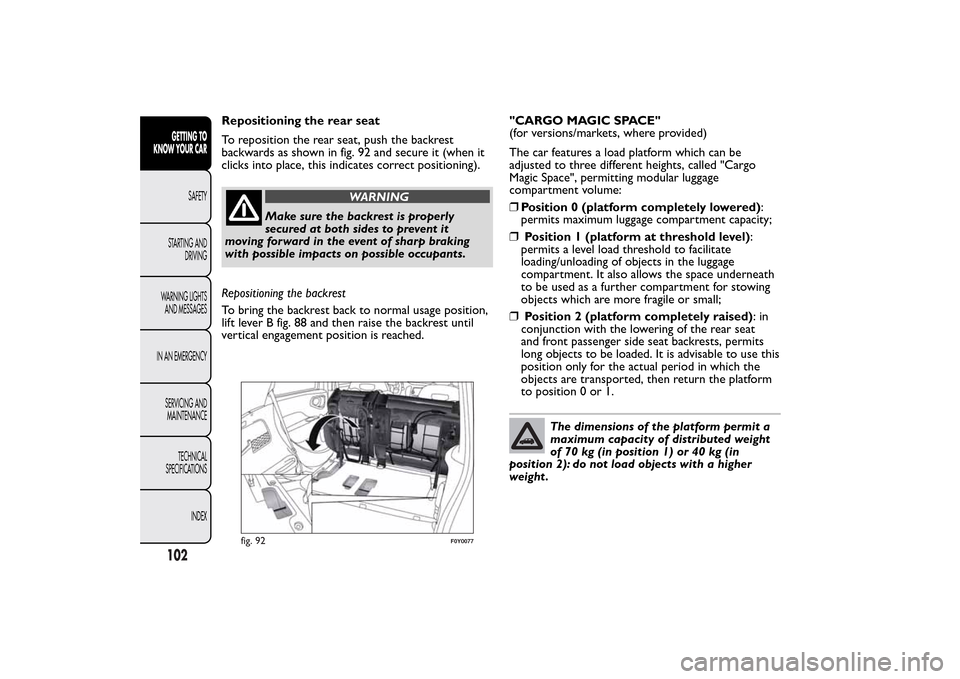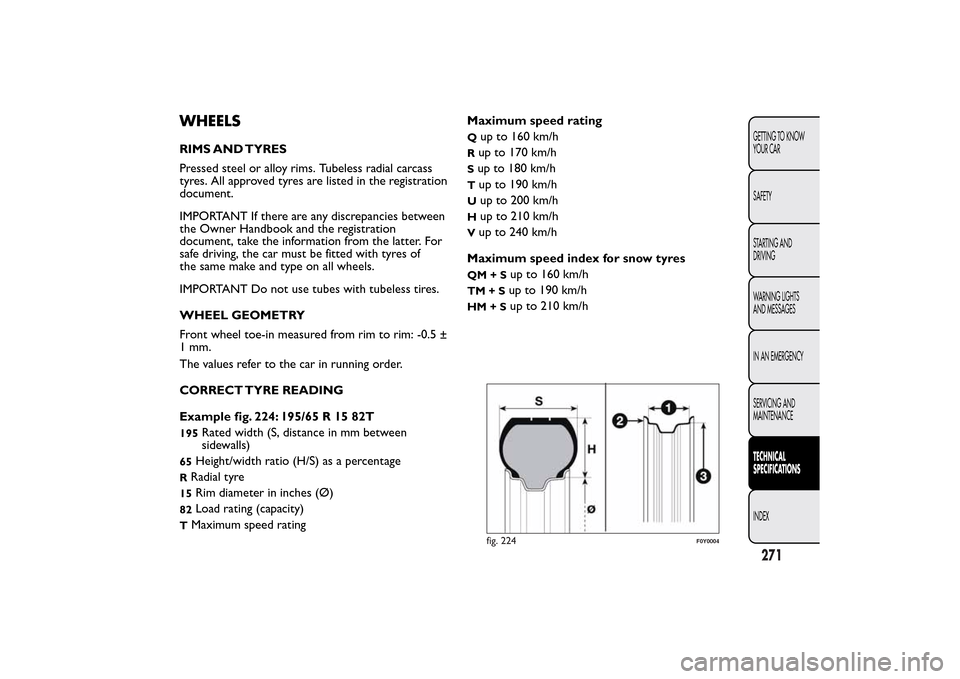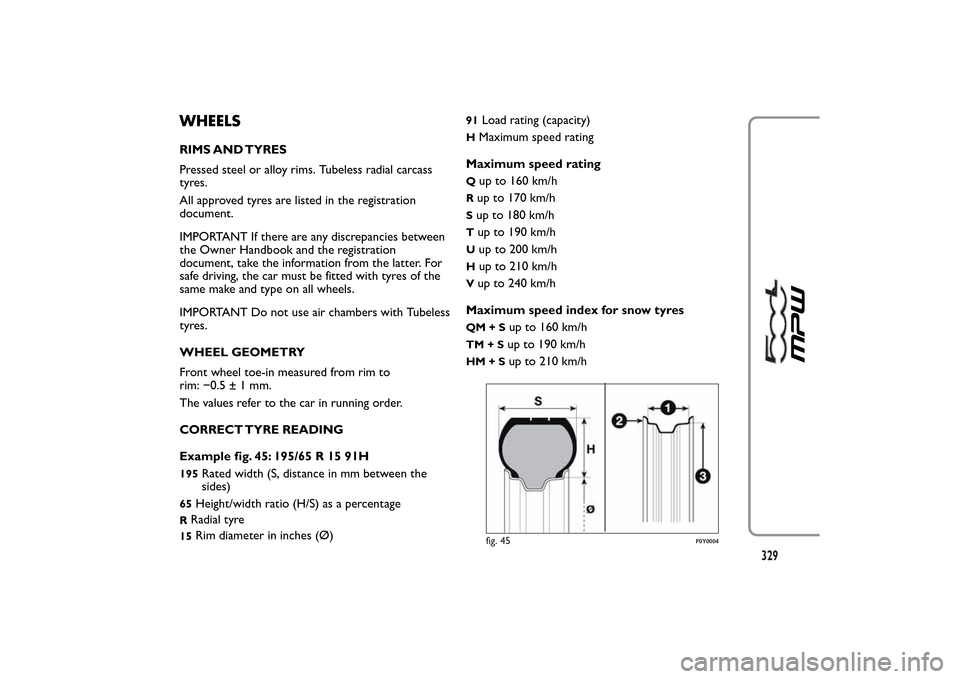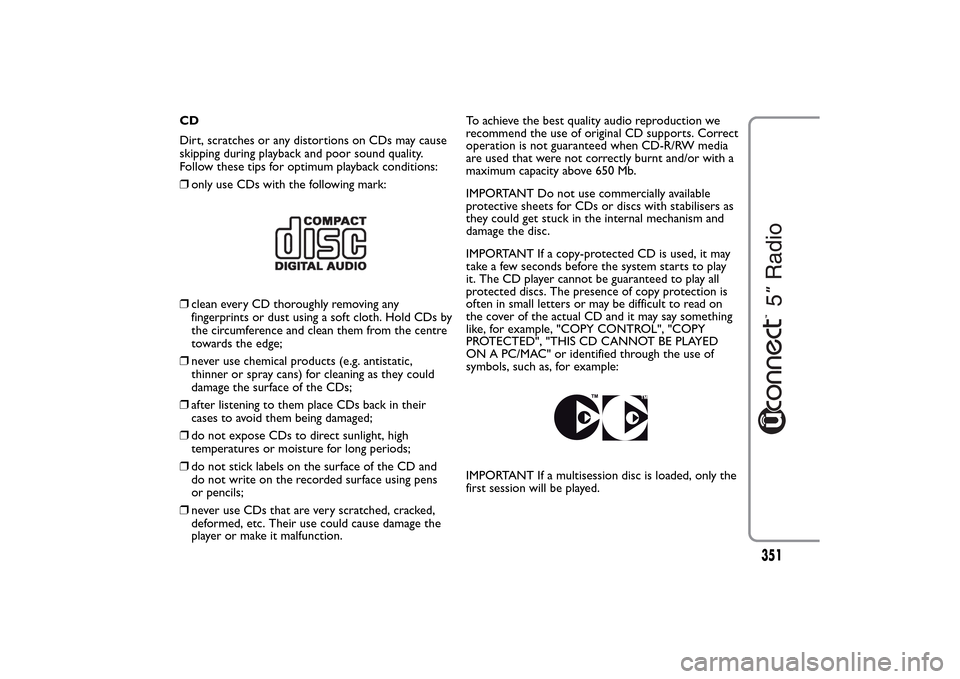Page 106 of 420

Repositioning the rear seat
To reposition the rear seat, push the backrest
backwards as shown in fig. 92 and secure it (when it
clicks into place, this indicates correct positioning).
WARNING
Make sure the backrest is properly
secured at both sides to prevent it
moving forward in the event of sharp braking
with possible impacts on possible occupants.
Repositioning the backrest
To bring the backrest back to normal usage position,
lift lever B fig. 88 and then raise the backrest until
vertical engagement position is reached."CARGO MAGIC SPACE"
(for versions/markets, where provided)
The car features a load platform which can be
adjusted to three different heights, called "Cargo
Magic Space", permitting modular luggage
compartment volume:
❒Position 0 (platform completely lowered):
permits maximum luggage compartment capacity;
❒Position 1 (platform at threshold level):
permits a level load threshold to facilitate
loading/unloading of objects in the luggage
compartment. It also allows the space underneath
to be used as a further compartment for stowing
objects which are more fragile or small;
❒Position 2 (platform completely raised):in
conjunction with the lowering of the rear seat
and front passenger side seat backrests, permits
long objects to be loaded. It is advisable to use this
position only for the actual period in which the
objects are transported, then return the platform
to position 0 or 1.
The dimensions of the platform permit a
maximum capacity of distributed weight
of 70 kg (in position 1) or 40 kg (in
position 2): do not load objects with a higher
weight .
fig. 92
F0Y0077
102GETTING TO
KNOW YOUR CAR
SAFETY
STARTING AND
DRIVING
WARNING LIGHTS
AND MESSAGES
IN AN EMERGENCY
SERVICING AND
MAINTENANCE
TECHNICAL
SPECIFICATIONS
INDEX
Page 179 of 420

CONDITIONS OF USE
Cold starting
Short distances and frequent cold start-ups will
prevent the engine from reaching optimal running
temperature.
Consequently, both consumption (from +15 to +30%
on urban cycle ) and emissions will increase.
Traffic and road conditions
Rather high fuel consumption is caused by heavy
traffic, for instance when travelling in a queue with
frequent use of low gears or in large towns with
many traffic lights.
Mountain and rough roads also have a negative effect
on fuel consumption.
Stops in traffic
During prolonged stops (e.g. level crossings) the
engine should be switched off.
TOWING TRAILERSIMPORTANT NOTES
For towing caravans or trailers the car must be fitted
with a type-approved tow hook and an adequate
electrical system. Installation must be carried out by
a specialist.
Install any specific and/or additional rear view mirrors
as specified by the Highway Code.
Remember that when towing a trailer, steep hills are
harder to climb, braking distances increase and
overtaking takes longer depending on the overall
weight of the trail.
Engage a low gear when driving downhill, rather than
constantly using the brake.
The weight of the trailer on the car's tow hook will
reduce the load capacity of the car by the same
amount. To make sure that the maximum towable
weight is not exceeded (given in the car registration
document) account should be taken of the fully
laden trailer, including accessories and luggage.
Respect the speed limits specific to each country for
vehicles towing trailers. In any case, the top speed
must not exceed 100 km/h.
175GETTING TO KNOW
YOUR CAR
SAFETYSTARTING AND
DRIVINGWARNING LIGHTS
AND MESSAGES
IN AN EMERGENCY
SERVICING AND
MAINTENANCE
TECHNICAL
SPECIFICATIONS
INDEX
Page 275 of 420

WHEELSRIMS AND TYRES
Pressed steel or alloy rims. Tubeless radial carcass
tyres. All approved tyres are listed in the registration
document.
IMPORTANT If there are any discrepancies between
the Owner Handbook and the registration
document, take the information from the latter. For
safe driving, the car must be fitted with tyres of
the same make and type on all wheels.
IMPORTANT Do not use tubes with tubeless tires.
WHEEL GEOMETRY
Front wheel toe-in measured from rim to rim: -0.5 ±
1 mm.
The values refer to the car in running order.
CORRECT TYRE READING
Example fig. 224: 195/65 R 15 82T195
Rated width (S, distance in mm between
sidewalls)
65
Height/width ratio (H/S) as a percentage
RRadial tyre15
Rim diameter in inches (Ø)
82
Load rating (capacity)
T
Maximum speed ratingMaximum speed rating
Q
up to 160 km/h
Rup to 170 km/hSup to 180 km/hT
up to 190 km/h
U
up to 200 km/h
H
up to 210 km/h
V
up to 240 km/h
Maximum speed index for snow tyres
QM+S
up to 160 km/h
TM+S
up to 190 km/h
HM+S
up to 210 km/h
fig. 224
F0Y0004
271GETTING TO KNOW
YOUR CAR
SAFETY
STARTING AND
DRIVING
WARNING LIGHTS
AND MESSAGES
IN AN EMERGENCY
SERVICING AND
MAINTENANCETECHNICAL
SPECIFICATIONSINDEX
Page 276 of 420
Load rating (capacity)
70= 335 kg81= 462 kg
71= 345 kg82= 475 kg
72= 355 kg83= 487 kg
73= 365 kg84= 500 kg
74= 375 kg85= 515 kg
75= 387 kg86= 530 kg
76= 400 kg87= 545 kg
77= 412 kg88= 560 kg
78= 425 kg89= 580 kg
79= 437 kg90= 600 kg
80= 450 kg91= 615 kg
CORRECT READING OF THE RIM CODE
Example fig. 224:6Jx15H26rim width in inches (1).Jrim drop centre outline (side projection where the
tyre bead rests) (2).15
rim fitting diameter in inches (corresponds to
diameter of the tyre to be mounted) (3 = Ø).
H2
shape and number of humps (circumference
measurement which keeps the bead of tubeless
tyres in position on the rim).
272GETTING TO KNOW
YOUR CAR
SAFETY
STARTING AND
DRIVING
WARNING LIGHTS
AND MESSAGES
IN AN EMERGENCY
SERVICING AND
MAINTENANCE
TECHNICAL
SPECIFICATIONS
INDEX
Page 312 of 420
WARNING
Make sure the backrest is properly
secured at both sides to prevent it
moving forward in the event of sharp braking,
with possible impact with the occupants. A
metallic click is heard when locking is correct .
THIRD ROW SEAT BACKREST FOLDING
Proceed as follows:
❒completely lower the third row rear seat head
restraints;
❒move the seat belts to the side, making sure that
they are correctly extended and not twisted;
❒pull upwards device A fig. 8 to fold the left or right
seat backrest. The backrest will be automatically
folded forwards. If necessary, accompany the
backrest during the initial stage of folding.The load compartment capacity increases when the
seat backrests are folded.
Before tilting the seat backrest fully,
remove any objects laid on it .
WARNING
Do not move the seat when a child is
sitting in the car.
fig. 8
F0Y0381
308
Page 333 of 420

WHEELSRIMS AND TYRES
Pressed steel or alloy rims. Tubeless radial carcass
tyres.
All approved tyres are listed in the registration
document.
IMPORTANT If there are any discrepancies between
the Owner Handbook and the registration
document, take the information from the latter. For
safe driving, the car must be fitted with tyres of the
same make and type on all wheels.
IMPORTANT Do not use air chambers with Tubeless
tyres.
WHEEL GEOMETRY
Front wheel toe-in measured from rim to
rim: −0.5±1mm.
The values refer to the car in running order.
CORRECT TYRE READING
Example fig. 45: 195/65 R 15 91H195
Rated width (S, distance in mm between the
sides)
65
Height/width ratio (H/S) as a percentage
RRadial tyre15
Rim diameter in inches (Ø)
91
Load rating (capacity)
H
Maximum speed rating
Maximum speed rating
Q
up to 160 km/h
Rup to 170 km/hSup to 180 km/hT
up to 190 km/h
U
up to 200 km/h
H
up to 210 km/h
V
up to 240 km/h
Maximum speed index for snow tyres
QM+S
up to 160 km/h
TM+S
up to 190 km/h
HM+S
up to 210 km/h
fig. 45
F0Y0004
329
Page 334 of 420
Load rating (capacity)
70= 335 kg81= 462 kg
71= 345 kg82= 475 kg
72= 355 kg83= 487 kg
73= 365 kg84= 500 kg
74= 375 kg85= 515 kg
75= 387 kg86= 530 kg
76= 400 kg87= 545 kg
77= 412 kg88= 560 kg
78= 425 kg89= 580 kg
79= 437 kg90= 600 kg
80= 450 kg91= 615 kg
CORRECT READING OF THE RIM CODE
Example fig. 45:6Jx15H26rim width in inches (1).Jprofile of the flange (side projection where the tyre
bead rests) (2).15
rim fitting diameter in inches (corresponds to the
diameter of the tyre to be mounted) (3 = Ø).
H2
shape and number of humps (circumference
measurement which keeps the bead of Tubeless
tyres in position on the rim).
330
Page 355 of 420

CD
Dirt, scratches or any distortions on CDs may cause
skipping during playback and poor sound quality.
Follow these tips for optimum playback conditions:
❒only use CDs with the following mark:❒clean every CD thoroughly removing any
fingerprints or dust using a soft cloth. Hold CDs by
the circumference and clean them from the centre
towards the edge;
❒never use chemical products (e.g. antistatic,
thinner or spray cans) for cleaning as they could
damage the surface of the CDs;
❒after listening to them place CDs back in their
cases to avoid them being damaged;
❒do not expose CDs to direct sunlight, high
temperatures or moisture for long periods;
❒do not stick labels on the surface of the CD and
do not write on the recorded surface using pens
or pencils;
❒never use CDs that are very scratched, cracked,
deformed, etc. Their use could cause damage the
player or make it malfunction.To achieve the best quality audio reproduction we
recommend the use of original CD supports. Correct
operation is not guaranteed when CD-R/RW media
are used that were not correctly burnt and/or with a
maximum capacity above 650 Mb.
IMPORTANT Do not use commercially available
protective sheets for CDs or discs with stabilisers as
they could get stuck in the internal mechanism and
damage the disc.
IMPORTANT If a copy-protected CD is used, it may
take a few seconds before the system starts to play
it. The CD player cannot be guaranteed to play all
protected discs. The presence of copy protection is
often in small letters or may be difficult to read on
the cover of the actual CD and it may say something
like, for example, "COPY CONTROL", "COPY
PROTECTED", "THIS CD CANNOT BE PLAYED
ON A PC/MAC" or identified through the use of
symbols, such as, for example:
IMPORTANT If a multisession disc is loaded, only the
first session will be played.
351